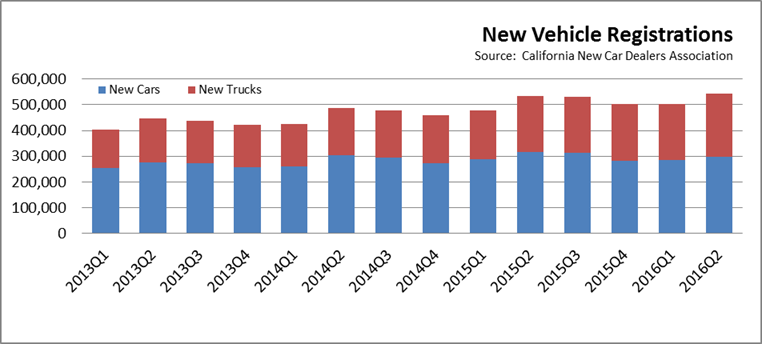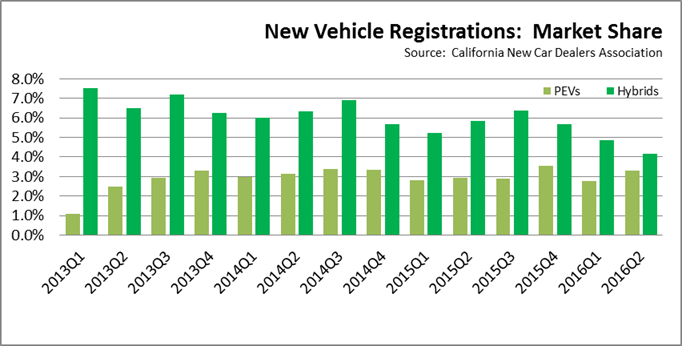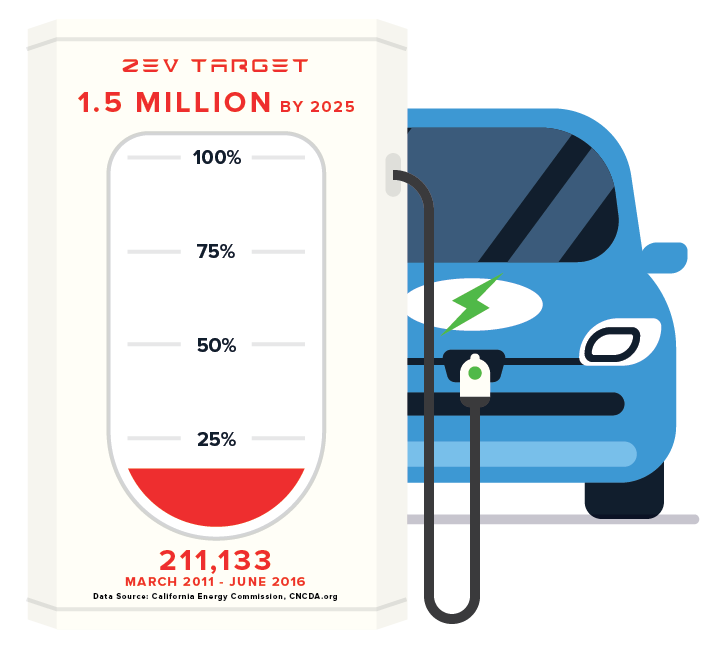The latest new vehicle sales data from California New Car Dealers Association shows continued but slowing growth in California’s purchases of new cars and trucks. Key findings from the data:
Californians Continue to Buy More Light Trucks as Fuel Prices Drop
- Total light vehicle sales in 2016 Q2: 542,565. Up 1.8% from 2015 Q2.
- Market share, cars: 54.8%. Down from 59.3% in 2015 Q2.
- Market share, light trucks: 45.2%. Up from 40.7% in 2015 Q2.
- California average price per gallon regular gasoline, 2016 Q2: $2.81. Down from $3.50 in 2015 Q2.

PEV Sales Up, Offset by Larger Drop in Hybrid Sales
- PEV sales (plug-in hybrids and battery electric vehicles) up 2,396 vehicles from 2015 Q2. Total market share for PEVs was 3.3%, up from 2.9% in 2015 Q2 but still below previous highs in 2014 and 2015.
- Hybrid sales (except for plug-in hybrids) down 8,440 vehicles from 2015 Q2. Total market share was 4.2%, down from 5.8% in 2015 Q2.

Total PEVs at 14.1% of 2025 Goal
As part of the AB 32 climate change program, Executive Order B-16-2012 administratively created a goal of 1.5 million zero-emission vehicles (ZEVs) on California roads by 2025, with a sub-goal that their market share is expanding at that point. The order also established interim mileposts primarily related to infrastructure support for recharging along with more qualitative targets for manufacturing capacity and commercial viability of these vehicles.
Accounting for normal fleet turnover rates and reductions from persons moving out of California, PEV sales would need to be 2.7 times as large in order to meet the 2025 goal.
The chart below is based on the Energy Commission’s baseline estimate of 146,000 PEVs between March 2011 and July 2015, and updated with the New Car Dealers’ quarterly sales data. This approach provides an overestimate of the number of PEVs actually registered in the state as it does not account for vehicles withdrawn from the fleet due to accidents, returns, trade-ins, owners moving out of the state, and other actions causing vehicles to be removed from the in-state fleet. This factor will be adjusted as the Commission updates its estimates in periodic reports.

Manufacturing Provisions of the Executive Order Still Not Implemented
Executive Order B-16-2012 also contains a number of provisions calling for actions to expand the ZEV and ZEV component manufacturing base in California:
- [By 2015] The State’s manufacturing sector will be expanding zero-emission vehicle and component manufacturing;
- [By 2020] The private sector’s role in the supply chain for zero-emission vehicle component development and manufacturing State will be expanding.
- [By 2025] The zero-emission vehicle industry will be a strong and sustainable part of California’s economy;
Rather than increasing the state’s competitiveness for an expanded manufacturing base, recent actions have instead increased the difficulty of siting and operating these facilities in California, including increasing the complexity and therefore litigation risks associated with the state’s employment laws, regulatory actions that contribute to industrial electricity rates that are 67% higher than the national average, the continuing expansion of the state’s already extensive California-only regulations, and a permitting and siting decision process that can take years to complete.
California’s ability to compete for these manufacturing facilities is illustrated by Tesla’s Gigafactory, which began partial operations only 13 months after selection of its site in Nevada was announced. In California, the CEQA and permitting process alone generally take far more time than this to complete.
View Article